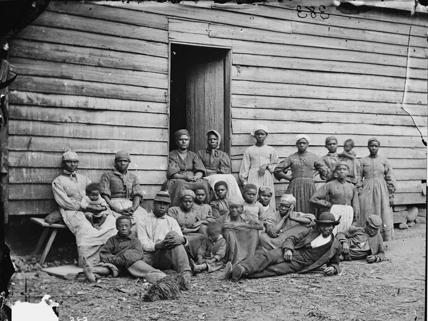
A group of “Contrabands” gather in Cumberland Landing, Virginia, 1862.
In Hampton, Virginia, archaeological excavations are unearthing a Civil War–era community that was inhabited by newly freed African Americans. During the early years of the war, runaway slaves were seeking the protection of the Union army at Fort Monroe, near Hampton. At the fort, they found freedom, thanks to commanding officer Major General Benjamin Butler. A lawyer before the war, Butler knew a legal loophole when he saw one: since southerners considered slaves to be property, and because slave labor was being exploited for the Confederate war effort, he concluded that escaped slaves should be treated as “contraband of war.” As such, they were illegal property subject to seizure by the occupying Union forces. As increasing numbers of fugitive slaves arrived at Fort Monroe, Butler put his “fugitive slave law” into effect, thus rendering the runaways free. These former slaves were themselves called “Contrabands.”
Fort Monroe was a Federal fortification located within Confederate territory. Yet, on August 7, 1861, the Confederate army elected to destroy Hampton to prevent its being of use to the Union. Hampton’s white citizens evacuated the port town, and the Confederate troops burned it to the ground. Charred chimneys and brick walls stood as ruins in what is now downtown Hampton. Here and in the surrounding countryside, African Americans from Fort Monroe formed a settlement that became known as the Great Contraband Camp. Escaped slaves from as far as North Carolina came to the camp. The example of these freed slaves, living safely under Union protection, may have inspired President Lincoln to conceive the Emancipation Proclamation.
The Great Contraband Camp and its environs are now the focus of archaeological study. Work began after the demolishing of run-down apartments opened up the area. To locate sites for excavation, archaeologists made use of 1870 census data, fire insurance company maps dating from 1905, and an aerial photograph of the apartment complex. So far, they have identified about 170 features for a closer look.
Image credit: Library of Congress, Prints and Photographs Division
Related Links
- Letter from Virginia: Free before Emancipation
This article, published by the Archaeological Institute of America, details what is known about the Grand Contraband Camp, now being excavated in Hampton, Virginia.
(Source: Archaeology magazine, July/August 2015) - Contraband Historical Society
This is the official website of the Contraband Historical Society, dedicated to fostering better race relations and encouraging understanding of the Contraband Slaves whose efforts created a moral, spiritual, and unified community.
(Source: Contraband Historical Society; accessed August 10, 2015) - Archaeologists Present First Public Report on Grand Contraband Camp Archaeology at Hampton History Museum
This press release by the Hampton History Museum announced the initial exhibition focusing on the archaeological work under way in Hampton.
(Source: DowntownHampton.com, November 3, 2014)



